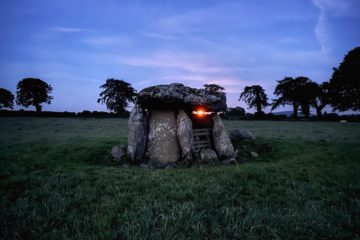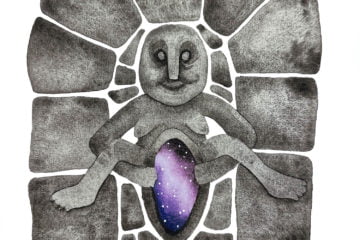
Recently we took a spin out to a site that had been on my list for a long time, the Knickeen Ogham Stone. Hidden in a forest clearing at the Glen of Imaal, this special place feels about as remote and secluded as you can get in Ireland. It is a bit of a drive to get out to, but once you arrive it is almost in view of where you park the car, making it a perfect spot to visit if you’re not up for a long hike or walk. What’s even better is that there is a good chance you will have it all to yourself!
Getting There
The stone is located ten minutes outside of the village of Donard in County Wicklow. Getting there is relatively simple with Google Maps. Just copy these exact co-ordinates into the search bar and it will bring you right to it: 52.995812,-6.536802
If you don’t want to use Google Maps, just head south-east from Donard for approximately four miles until you come to a crossroads. You can park the car off the road here. The road to your left will be an entrance through a managed forest. If you walk a couple of meters down this road you will spot the stone on your right in a grassy clearing.
The Stone
The stone itself is approximately 1500 years old, having been dated to somewhere between 400 AD and 550 AD. It is bigger than you might expect, standing at an imposing eight feet tall. Its shape is also unusual, as it is far wider at the top than at the bottom, almost giving it the appearance of a heart.
The Ogham inscription on the North East corner reads ‘Maqi Nili’, which broadly means ‘Of the son of Niall’. Ogham is the oldest form of writing in the early Irish language and was used for about 500 years from the Early Christian era.
There is a local myth that I found on dúchas.ie about the stone, which says that it was thrown by Fionn Mac Cumhaill from the top of Lugnaquilla, and that the markings on the edge of the stone are the imprints of his fingers.

The Place
There is no way that I can exaggerate how incredible this place is. Surrounded by panoramic mountains and woods, the stone stands in a small grassy clearing looking out on the formidable view. The area is very secluded, and absent of any sound except for the hum of nature.
On the day of our visit it was a warm and wet afternoon in June. Far off in the distant mountains the roll of thunder could be heard, though luckily for us we arrived between showers, just as the sun was poking through the clouds.
The grass underfoot was long and soaked as we picked our way to the stone. The noise of frogs, grasshoppers, birds and buzzing insects simply filled the air around it, and as we drew closer became a cacophony. We even witnessed a large frog resting right next to a beautiful red peacock butterfly on a stump close by.
The stone dominated the view of the area, and energy around it was electrifying. It truly felt like a secret, magical place that we had found. We spent a good hour there taking in the atmosphere and getting as many photos as we could, before heading back to the car as the rain began to fall.

In Conclusion
Though we do not know what the true purpose of the stone was, or what it was originally supposed to mark, this does not diminish the sense of history that surrounds it. Standing in front of it and resting a hand on the ancient inscription, one cannot help but wonder whose expert hands carved the markings so cleverly upon its side.
So if you’re looking for a place to spend an afternoon that is off the beaten track, I highly recommend it. It’s a small piece of Irish history that is well worth a visit.


